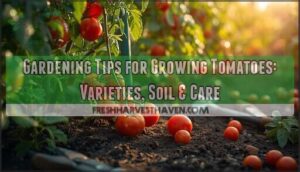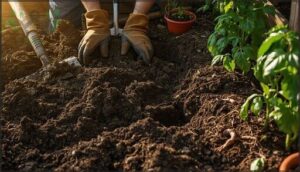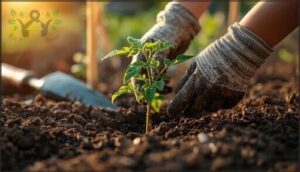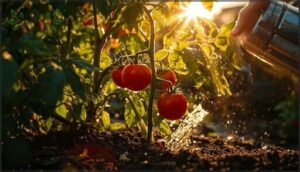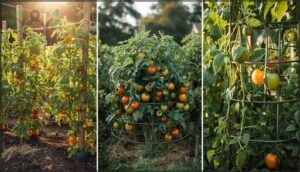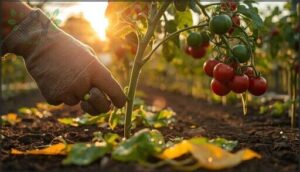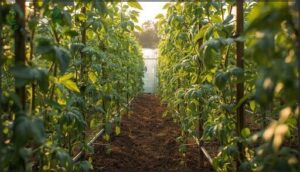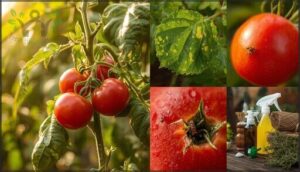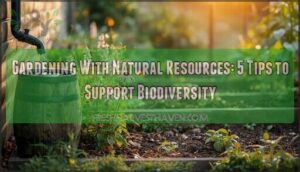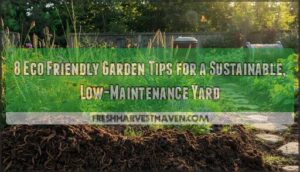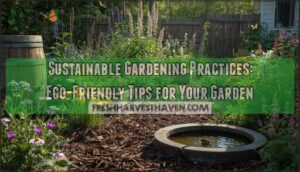This site is supported by our readers. We may earn a commission, at no cost to you, if you purchase through links.
Growing tomatoes seems straightforward until your first plants wilt, split open, or produce disappointing yields. The difference between a struggling tomato patch and one that thrives often comes down to choices made long before you set a single seedling in the ground.
Selecting the right variety for your climate, building soil that actually fosters growth, and understanding when to stake versus prune—these decisions shape everything that follows.
The good news is that tomato gardening doesn’t require magic, just the right combination of techniques matched to your specific situation. Whether you’re working with limited space, fighting pests, or simply trying to increase your harvest, the gardening tips for growing tomatoes covered here address the real challenges you’ll face.
Table Of Contents
- Key Takeaways
- Choosing The Best Tomato Varieties
- Preparing Soil for Tomato Success
- Planting Tomatoes for Healthy Growth
- Watering and Sunlight Essentials
- Supporting and Pruning Tomato Plants
- Preventing Pests, Diseases, and Problems
- Frequently Asked Questions (FAQs)
- How to grow a tomato garden?
- How do I select a tomato plant?
- How do you care for a tomato plant?
- How do I choose the right tomatoes for my garden?
- How do you grow a tomato plant in a pot?
- Can new gardeners grow tomatoes at home?
- When should I harvest ripe tomatoes?
- How do I store fresh tomatoes properly?
- Can I grow tomatoes in containers successfully?
- What causes tomato blossom end rot?
- Conclusion
Key Takeaways
- Choosing the right tomato variety for your climate and space—determinate for short seasons and containers, indeterminate for long growing periods—sets the foundation for your harvest success.
- Deep planting (burying stems to the first true leaves), consistent watering at the root zone, and proper spacing create strong root systems while preventing common diseases like blossom end rot.
- Supporting plants with stakes or trellises increases fruit production by 171% compared to unsupported plants, while strategic pruning of suckers produces 25% larger individual tomatoes.
- Disease prevention through crop rotation, tool sanitation, selecting resistant varieties, and maintaining proper air circulation reduces fungal infections by 40-60% without heavy chemical use.
Choosing The Best Tomato Varieties
Picking the right tomato variety is the first step toward a successful harvest. You’ll need to match your choice to your garden space, climate, and how you plan to use your tomatoes.
Let’s look at the key factors that will help you choose varieties that thrive in your conditions.
Determinate Vs. Indeterminate Types
Before you choose tomato varieties, understand growth habit—it shapes everything from harvest timing to support needs. Determinate tomatoes grow 2–4 feet tall, produce fruit over 4–6 weeks, and need minimal staking. Indeterminate tomatoes reach 6–10 feet, fruit continuously until frost, and require sturdy trellising. Your choice affects yield potential, pruning demands, and climate suitability: Determinate tomatoes are known for their bulk harvesting, making them ideal for canning.
- Determinates excel in short seasons with concentrated harvests for sauces.
- Indeterminates thrive in long, warm climates, delivering fresh fruit weekly.
- Supporting indeterminate tomatoes demands tall stakes and regular pruning for air circulation.
Heirloom Vs. Hybrid Tomatoes
Beyond growth habit, you’ll decide between heirloom and hybrid tomato varieties—each offers distinct advantages. Heirlooms deliver outstanding flavor profiles, with 40% higher sensory scores in taste tests, and allow seed saving with 95% genetic stability year-to-year. Hybrids counter with 20–30% higher yields and disease-resistant varieties that reduce wilt infections by 90%. Understanding the differences between these types, such as how heirloom tomatoes are open-pollinated, can further guide your decision. Your choice hinges on priorities: remarkable taste versus reliability and performance.
| Characteristic | Heirloom Varieties | Hybrid Varieties |
|---|---|---|
| Yield Performance | 5–7 fruits per plant | 10–15 fruits per plant |
| Disease Resistance | 30% higher susceptibility | 90% reduction in infections |
| Flavor & Nutrition | 10–15% more lycopene | Uniform but less complex |
| Seed Saving | True-to-type, 95% consistency | 80% variability if saved |
| Best Use | Flavor-focused gardening | Commercial, reliable yields |
Selecting for Climate and Season
Your climate dictates which tomatoes will thrive or fail in your garden. Match varieties to your frost-free days and growing zone—short-season regions need early-season varieties maturing in 50–60 days, while long seasons support indeterminate types.
Consider these climate factors:
- Heat tolerance for nighttime temperatures above 21°C (70°F)
- Humidity resistance in wet, disease-prone areas
- Growth habit aligned with season length before first frost
Best Varieties for Containers
Limited space doesn’t mean limited harvests. Determinate tomatoes excel in containers, staying compact at 2-4 feet tall—varieties like Patio Princess and Bush Early Girl fit 5-gallon pots perfectly. Dwarf varieties such as Tiny Tim thrive in smaller containers with proper drainage holes.
Cherry options like Washington Cherry deliver abundant yields, while hybrid choices like Better Bush F1 combine disease resistance with manageable size. Match container size to your chosen tomato variety for best results.
Preparing Soil for Tomato Success
Good soil is the foundation your tomato plants will lean on all season long. You can’t expect a strong harvest from tired, compacted ground that lacks nutrients and drains poorly.
Let’s look at two key steps to get your soil ready before you plant.
Amending With Compost and Nutrients
Your tomato plants eat constantly throughout the season, so healthy soil starts with smart compost application. Mix 1 to 2 inches of aged compost into beds before planting to improve soil structure and boost microbial life. This organic amendment increases nutrient-holding capacity and prevents nutrient deficiencies.
Monitor soil pH between 6.0 and 6.8, and add calcium sources monthly when fertilizing tomato plants to avoid blossom end rot.
Raised Beds Vs. Ground Planting
Where should you plant your tomatoes—in raised beds or directly in the ground? Raised beds warm faster in spring, advancing your planting window by weeks, and eliminate soil compaction since you work from paths. They demand higher labor costs upfront and dry quickly, requiring frequent watering.
In-ground gardens use existing soil conditions, need less irrigation, and cost less initially, though accessibility and air circulation around root systems may suffer in heavy clay.
Planting Tomatoes for Healthy Growth
Once you’ve chosen your varieties and prepped the soil, it’s time to actually get those tomatoes in the ground. How you plant makes a real difference in root development, disease resistance, and overall plant strength.
Let’s walk through the key techniques that’ll set your tomatoes up for a productive season.
Planting Depth and Spacing
Burying your transplant stems deep—to the first true leaves—builds a stronger root system and can boost early yields by half a ton per hectare. Horizontal burial works just as well in shallow beds.
Space plants adequately to balance airflow risk and productivity:
- Determinate types: 60–75 cm apart, 1.2 m row spacing
- Staked indeterminate: 45–60 cm within rows
- Caged indeterminate: 75–90 cm spacing
- Sprawling types: 90–120 cm for air circulation
Proper vertical depth and plant density prevent disease while maximizing harvest.
Starting Seeds Vs. Seedlings
You’ll save roughly 99% per plant through seed starting—a $5 seed packet beats five-dollar nursery tomato seedlings—but it demands controlled warmth near 75–85 °F and adequate light.
Transplants deliver faster harvests, stronger root development, and less skill requirement, though variety access narrows to three or four common types.
Seedling care mitigates transplant shock when you harden plants properly before moving outdoors.
Timing Planting for Your Zone
Your USDA zone sets the growing season clock. Start seeds indoors 6–8 weeks before your last frost date—early April in Zones 5–6, late February in Zones 7–8. Soil temperature must hit 60 °F minimum before transplanting tomatoes outdoors.
Fall planting works in Zones 8–10 by mid-August. Harden off seedlings gradually, and watch microclimates that shift dates by a week.
Transplanting Techniques
Harden off tomato seedlings for 7–10 days before transplanting—start with 2 hours outdoors, gradually increasing exposure until they tolerate full sun.
Plant 5–10 cm deeper than the container line to promote root health along the buried stem.
Water deeply after planting, then maintain consistent moisture for 10 days to minimize shock.
Apply half-strength starter fertilizer high in phosphorus to support early root growth.
Watering and Sunlight Essentials
Once your tomatoes are in the ground, two factors will make or break your harvest: water and sunlight. Get these wrong, and you’ll end up with stunted plants, cracked fruit, or disappointing yields.
Here’s how to give your tomatoes exactly what they need to thrive.
Deep and Consistent Watering
Water at the base of your tomato plants rather than overhead to keep soil moisture consistent where it matters most—in the root zone 20 to 30 cm deep. Aim for 25 to 38 mm of water volume per week, delivered in one or two deep soakings.
Proper watering techniques, especially drip irrigation, maintain steady soil moisture and prevent blossom-end rot better than frequent, shallow sprinkling.
Mulching to Retain Moisture
Once you’ve nailed your watering routine, mulching becomes your moisture-retention partner. A 2–3 inch layer of organic mulch around your tomato plants cuts soil water loss by up to 50%, meaning you’ll water less often while your plants stay consistently hydrated.
Here’s what mulch delivers:
- Reduces soil evaporation and irrigation needs considerably
- Suppresses weeds competing for moisture and nutrients
- Lowers disease incidence by 40–60% through stable moisture
- Increases beneficial fungi that boost water uptake efficiency
Leave 1 inch of space around stems to prevent rot.
Maximizing Sunlight Exposure
Your tomato plants need at least 6–8 hours of direct sunlight daily for best fruit production. Position taller indeterminate varieties on the north side of shorter plants to prevent self-shading. Space plants 24–36 inches apart to improve light penetration into the canopy.
In dense growth, remove excess foliage strategically to let sunlight reach developing fruit. Reflective mulches boost available light by reflecting radiation back into the canopy.
Map your garden’s sunlight patterns over several days, accounting for seasonal changes in tree cover and building shadows, to maintain adequate sun exposure throughout the growing season.
Supporting and Pruning Tomato Plants
As your tomato plants grow taller and heavier with fruit, they’ll need support to stay upright and healthy. The right support system also improves air circulation around the foliage, which helps prevent disease and keeps your plants strong.
Here are the main ways to support and trellis your tomatoes, along with the pruning techniques that work best with each method.
Staking, Caging, and Trellising
Getting your tomato plants off the ground transforms everything. Staking, caging, and trellising aren’t just nice extras—they’re game-changers for yield and quality. A 2025 study showed trellised plants produced 171% more fruit than unsupported ones.
Trellised tomato plants produce 171% more fruit than unsupported ones, transforming yield and quality through proper support
Closer spacing with stakes or trellises maximizes your garden footprint, while cages work best for vigorous varieties. Choose based on your plants’ habits and available space.
Pruning Suckers and Lower Leaves
Through strategic sucker removal and leaf defoliation, you’ll transform your tomato plants’ productivity and health. Suckers—those vigorous shoots sprouting from leaf joints—compete with fruit for energy, so removing them when small (5–10 cm) minimizes plant stress.
Research shows pruned plants produce 25% larger fruits, though unpruned ones yield 38% more total weight. Your pruning intensity matters: remove no more than one-third of foliage per session to maintain photosynthesis.
Remove bottom leaves (up to 30 cm high) to reduce soil-borne diseases and improve canopy structure. Time pruning weekly during peak growth, disinfecting tools between plants to prevent pathogen spread.
Improving Air Circulation
When foliage crowds together, fungal diseases flourish—but proper air movement stops them cold. Space determinate varieties 18–24 inches apart and indeterminate types 24–36 inches to reduce disease by 40–60%. Trellising lifts plants off soil, cutting fungal risk by half. Remove lower leaves to block soil-borne pathogens. In greenhouses, fans decrease humidity 15–30%, slashing fungicide needs by 40%. Strong airflow transforms plant health and yield.
| Method | Disease Reduction | Implementation |
|---|---|---|
| Plant spacing | 40–60% | 18–36 inches apart |
| Trellising | Up to 50% | Stakes, cages, strings |
| Leaf pruning | 30–50% | Remove lower 6–12 inches |
| Greenhouse fans | 40% fungicide reduction | Reduce humidity 15–30% |
Preventing Pests, Diseases, and Problems
Even the healthiest tomato plant can face setbacks from pests, diseases, and environmental stress. The good news is that most of these problems are preventable or manageable once you know what to watch for.
We’ll walk you through the main challenges and how to keep your plants thriving.
Common Tomato Pests and Controls
Several pests can threaten your harvest, but knowing how to identify and manage them makes all the difference. Hornworm control through daily hand removal reduces defoliation by over 50% on small plantings.
Aphid management using integrated pest management boosts yields by 23%. Whitefly prevention benefits from beneficial parasitic wasps like Encarsia formosa.
Mite thresholds of 8-12 per leaf guide spray timing. Fruitworm IPM, using action thresholds, combined with these tactics, increases income by 34% while protecting your fruit.
Disease-Resistant Varieties
Disease-resistant varieties are your first line of defense against soil-borne pathogens. When you select hybrids with resistance codes like VFN—protecting against verticillium wilt, fusarium wilt, and nematodes—you’re stacking the odds in your favor. Over 80% of hybrid transplants now carry at least one resistance code.
Cherry types like ‘Sun Gold’ offer both productivity and disease resistance, while grafting benefits combine vigor with protection.
Match resistance packages to your regional pressure, and you’ll harvest more reliably, season after season.
Preventing Blossom End Rot
Blossom end rot—that dark, sunken spot on your fruit—signals calcium deficiency, not poor soil. It hits hardest when soil pH drifts below 6.5 or watering turns erratic.
Maintain soil pH between 6.5–6.8, apply mulch to stabilize moisture, and water deeply 1–2 times weekly rather than daily sprinkles. Avoid heavy nitrogen fertilization early on, which outpaces calcium transport.
Choose less-susceptible cultivars, and you’ll catch fewer affected fruits from the start.
Cleaning Tools and Crop Rotation
Your tools are vectors for disease—pathogens hide in soil and sap, spreading silently between plants. Disinfect pruning clippers and all equipment with a 10% bleach solution after each plant to stop cross-contamination. Simultaneously, rotate crops annually with non-solanaceae crops like beans or cabbage, breaking pathogen cycles that accumulate in monoculture. This integrated disease management approach tackles both aboveground and soilborne threats:
- Clean tools between plants with bleach
- Rotate tomatoes every 3 years minimum
- Remove crop debris post-harvest
- Monitor soil for pathogen buildup
Frequently Asked Questions (FAQs)
How to grow a tomato garden?
Start by choosing a variety suited to your climate, then prepare well-draining soil with compost. Plant deeply, water consistently (1–2 inches weekly), provide 6–8 hours of sunlight, and support plants with stakes.
How do I select a tomato plant?
You want seedlings 15 to 30 cm tall with thick stems and dark green leaves—no flowers yet.
Check disease-resistant varieties suited to your climate, and inspect roots for white, fibrous growth without circling.
How do you care for a tomato plant?
Caring for tomato plants means balancing watering frequency with nutrient balance, pruning techniques, and sunlight needs. Address common problems early—water deeply three to four times weekly, prune suckers to improve air circulation, and fertilize during fruiting.
How do I choose the right tomatoes for my garden?
Choose tomato varieties by balancing flavor profiles, tomato size, and plant vigor with your space constraints and garden goals.
Disease-resistant varieties reduce maintenance, while selecting tomato seeds suited to your climate ensures reliable harvests.
How do you grow a tomato plant in a pot?
Growing a tomato plant in a pot requires selecting the right container size—at least 5 gallons for determinate varieties and 15 gallons for indeterminate types—along with quality potting mix, consistent watering, and full sun exposure.
Can new gardeners grow tomatoes at home?
You can absolutely grow tomatoes at home, even as a beginner.
Start with beginner tomato types like ‘Celebrity’ or ‘Roma’. Follow easy techniques for planting tomato seedlings, watering tomato plants consistently, and providing basic plant care.
When should I harvest ripe tomatoes?
Harvest tomatoes when they’re fully colored, firm yet yielding slightly to gentle pressure. Morning harvests work best.
For maximum flavor and nutritional changes, pick fruit at the red stage. Tomato harvesting techniques that prioritize texture firmness and color maturity deliver excellent eating quality.
How do I store fresh tomatoes properly?
Store ripe tomatoes at room temperature for three to five days to preserve flavor.
For longer storage, refrigeration slows decay, but return them to room temperature before eating for best taste.
Can I grow tomatoes in containers successfully?
Yes, you can grow tomatoes successfully in containers. Choosing tomato varieties suited for pots, selecting the right pot size, preparing quality soil, and maintaining consistent watering practices help produce healthy plants and productive harvests.
What causes tomato blossom end rot?
Blossom end rot stems from calcium deficiency in fruit tissues, triggered by water stress, irregular watering practices, or nutrient imbalance. Environmental stress and poor soil pH levels disrupt calcium uptake, leading to yield loss despite adequate soil calcium.
Conclusion
Think of a tomato plant as a living bridge between your intention and the harvest you envision. Each decision—variety selection, soil preparation, watering rhythm—becomes a supporting beam in that structure.
The gardening tips for growing tomatoes outlined here give you the framework, but your attentiveness completes it. When you match technique to your specific conditions and stay observant, you won’t just grow tomatoes. You’ll cultivate resilience, flavor, and abundance season after season.
- https://extension.umn.edu/vegetables/growing-tomatoes
- https://extension.colostate.edu/topic-areas/yard-garden/recognizing-tomato-problems-2-949/
- https://extension.uga.edu/publications/detail.html?number=B1271&title=georgia-homegrown-tomatoes
- https://thehomesteadingrd.com/determinate-vs-indeterminate-tomatoes/
- https://fieldreport.caes.uga.edu/publications/C1150/staking-and-pruning-tomatoes-in-the-home-garden/

